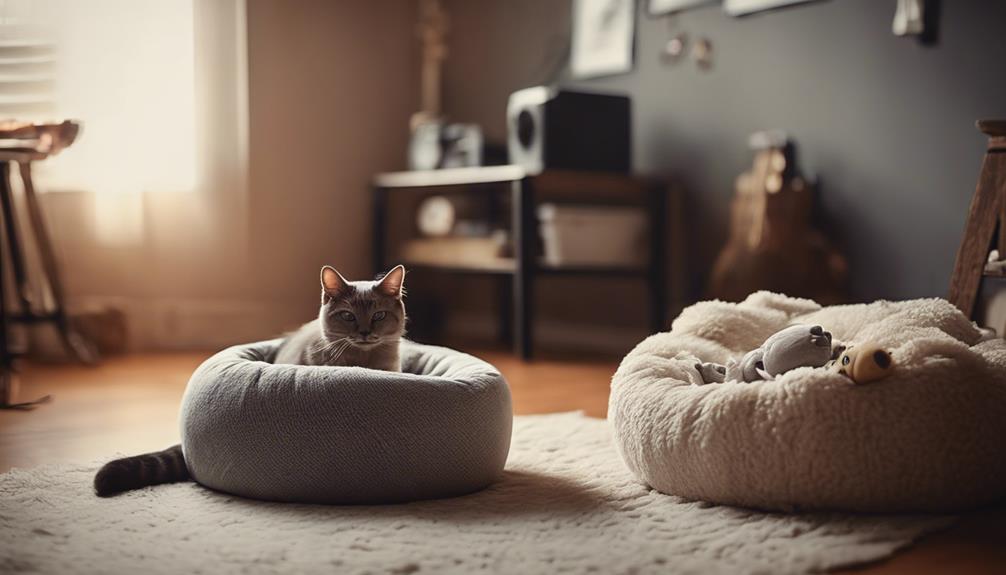What to Do When Your Cat Hides From Guests

Cats are known for being independent and sometimes aloof creatures. When guests come over, they may feel overwhelmed by the new people in their environment and seek a safe place to hide. This behavior is a natural response for cats when they feel stressed or threatened. To help your cat feel more secure when guests are around, create a safe space where they can retreat to, such as a quiet room with their favorite toys and bedding. Additionally, you can provide hiding spots throughout your home where your cat can feel hidden and secure. By giving your cat these options, you can help them feel more comfortable and reduce their stress levels when guests are visiting.
Understanding Your Cat's Behavior
Understanding how your cat reacts to unfamiliar situations can provide valuable insights into why it may hide from guests. Feline psychology plays a crucial role in how cats socialize and interact with their environment. Cats are known to be territorial animals, often feeling stressed when faced with new people or changes in their surroundings. This stress can manifest through various cat body language and stress cues, such as dilated pupils, flattened ears, or a twitching tail.
Socialization plays a significant role in how comfortable your cat feels around strangers. Cats that weren't adequately socialized as kittens may be more prone to hiding or displaying fearful behaviors when guests visit. It's essential to observe your cat's body language and stress cues to understand their emotions better.
Creating Safe Spaces

To help your cat feel more at ease when guests are over, consider creating designated safe spaces where your feline friend can retreat and relax. Providing a feline sanctuary allows your cat to have a secure retreat when feeling overwhelmed by visitors. These safe spaces can be set up in quiet rooms away from the hustle and bustle, equipped with your cat's favorite bedding, toys, and a litter box. It's essential to ensure that these areas are easily accessible to your cat at all times.
When designing a secure retreat for your cat, consider incorporating cozy hiding spots like cat condos, shelves, or even cardboard boxes. These areas should be quiet, dimly lit, and free from loud noises or sudden movements that could startle your cat. By creating a peaceful environment tailored to your cat's preferences, you provide them with a safe haven where they can feel comfortable and secure amidst the presence of guests.
Gradual Exposure to Guests

Consider introducing your cat to guests gradually to help them acclimate to new people in a calm and controlled manner. Behavior modification techniques such as desensitization training can be beneficial in this process. By slowly exposing your cat to guests in a controlled environment, you can help reduce their anxiety and fear, making interactions more positive for both your cat and your guests.
To implement gradual exposure effectively, follow these steps:
| Steps for Gradual Exposure | Description |
|---|---|
| 1. Start with One Guest | Begin by having a single guest visit your home. |
| 2. Use Treats and Positive Reinforcement | Encourage positive associations through treats and praise. |
| 3. Increase Exposure Gradually | Slowly increase the duration and number of guests over time. |
| 4. Monitor Your Cat's Behavior | Watch for signs of stress or discomfort and adjust accordingly. |
| 5. Patience and Consistency | Be patient and consistent in your approach for best results. |
Providing Comforting Resources

When helping a cat that hides from guests, providing comforting resources can make a big difference. Safe hiding spots, like cozy beds or quiet rooms, offer a sense of security.
Calming scents or gentle interactions can also help create a soothing environment for your cat.
Safe Hiding Spots
Where can your cat find a safe hiding spot when guests come over? Here are three options to consider:
- Cozy nooks: Create cozy hiding spots in quiet areas of your home. Provide your cat with access to small spaces like under the bed or behind furniture where they can feel safe and secure.
- Secure hiding: Ensure that the hiding spot is secure and easily accessible for your cat. Avoid areas that are difficult to reach or where they may feel trapped. A secure hiding spot will help your cat feel more comfortable and less stressed.
- Cat tree or hiding furniture: Invest in a cat tree or hiding furniture that provides elevated hiding spots for your cat. Cats often feel safer when they can observe their surroundings from a higher vantage point.
Calming Scents
To help your cat feel more at ease during social situations, introducing calming scents into their environment can provide comforting resources. Aromatherapy benefits can be a valuable tool in reducing stress and anxiety for your feline friend. Certain soothing essential oils like lavender, chamomile, or rosemary can promote relaxation and create a sense of calm in their surroundings.
You can use these scents by diffusing them in the room where your cat spends the most time or by adding a few drops to their bedding. Remember to always ensure that the oils are pet-safe and properly diluted to prevent any adverse reactions. Implementing relaxation techniques through calming scents can significantly contribute to creating a peaceful environment for your cat.
Gentle Interactions
Introducing gentle interactions can be a valuable way to provide comforting resources for your cat during social situations. These interactions can help build trust and strengthen the bond between you and your feline friend. Here are some tips for incorporating gentle interactions into your cat's routine:
- Bonding activities: Engage in activities that your cat enjoys, such as interactive play sessions or grooming. These activities can help your cat feel more comfortable and secure around guests.
- Trust building exercises: Use positive reinforcement techniques to build trust with your cat. Offer treats, gentle petting, and soothing words to create a positive association with social interactions.
- Socialization techniques: Gradually expose your cat to guests in a calm and controlled manner. Use toys or treats to redirect their focus and encourage positive communication strategies.
Positive Reinforcement Techniques

Positive reinforcement techniques can be effective in encouraging your cat to feel more comfortable around guests. Rewarding behavior that aligns with the desired outcome is key. When your cat displays positive behavior, such as coming out to investigate guests from a safe distance or engaging in play while visitors are around, offering treats or verbal praise can help reinforce this behavior.
By associating guests with positive experiences like treats or playtime, your cat can start to build positive associations and feel more at ease when visitors are present. Consistency is crucial in reinforcing these behaviors, so ensure that rewards are given each time your cat displays the desired behavior around guests. This consistency helps in encouraging trust between your cat and guests.
Over time, with patience and positive reinforcement, your cat may become more accustomed to guests and feel less inclined to hide.
Seeking Professional Help

If your cat's behavior around guests continues to be a concern, seeking professional help from a veterinarian or animal behaviorist may provide valuable insights and solutions. Here are some steps to consider:
- Behavior Therapy:
A professional can assess your cat's behavior to determine the underlying cause of their anxiety or fear around guests. They can then recommend behavior therapy techniques tailored to your cat's specific needs, which may include desensitization exercises or counterconditioning.
- Cat Behaviorists:
Cat behaviorists specialize in understanding feline behavior and can offer expert advice on how to address your cat's hiding behavior. They can work with you to develop a personalized plan to help your cat feel more comfortable and secure when guests are around.
- Medical Evaluation:
Sometimes, hiding behavior can be a sign of an underlying medical issue. A veterinarian can conduct a thorough examination to rule out any health problems that may be contributing to your cat's behavior and recommend appropriate treatment if necessary.
Patience and Consistency

When dealing with a cat that hides from guests, patience and consistency are key. Providing quiet, safe spaces where your cat can retreat to is essential.
Slowly introducing guests to your cat in a calm and controlled manner can help reduce their fear and anxiety.
Quiet, Safe Spaces
Creating a designated quiet and safe space for your cat requires patience and consistency. Here are three key steps to help your feline friend feel secure and comfortable:
- Cozy Corners: Provide your cat with cozy spots around the house where they can retreat whenever they feel overwhelmed. These can be soft beds, blankets, or even cardboard boxes.
- Tranquil Retreats: Designate a quiet room where your cat can escape to when guests visit. Ensure this space has all your cat's essentials – food, water, litter box, and toys.
- Consistent Environment: Keep this safe space consistent and undisturbed. Encourage your cat to associate this area with relaxation and security by placing familiar items like their favorite blanket or toy inside.
Slowly Introduce Guests
To help your cat adjust to guests, gradually introduce them in a calm and controlled manner. Start by having guests make short visits and stay relaxed around your cat. Encourage visitors to avoid sudden movements or loud noises that could startle your feline friend.
Provide a safe space where your cat can observe guests from a distance and retreat if needed. Use treats and toys to create positive associations with visitors. Over time, increase the duration of visits and the number of guests to slowly acclimate your cat to social interactions.
Consistency is key in this gradual approach; be patient and understanding as your cat builds trust with new people. By approaching introductions thoughtfully, you can help your cat feel more at ease around guests.
Frequently Asked Questions
How Can I Prevent My Cat From Hiding in the First Place?
To prevent a cat from hiding, create safe spaces with cozy beds or hiding spots. Use positive reinforcement techniques like treats and toys to encourage them to explore openly. Consistent love and patience foster trust.
Is It Possible for My Cat to Become Aggressive Towards Guests When Hiding?
When a cat hides due to anxiety, guest interaction can trigger feline aggression. Understanding cat behavior is crucial to prevent such reactions. Patience, creating safe spaces, and gradual exposure to guests can help your cat feel more comfortable.
Can I Train My Cat to Come Out and Socialize With Guests on Their Own?
Encourage your cat to socialize by creating a cat-friendly environment, using positive reinforcement, and behavior modification techniques. Gradually introduce guests, provide hiding spots, and respect your cat's space. With patience, your cat can learn to feel comfortable around visitors.
Are There Any Specific Breeds of Cats That Are More Prone to Hiding From Guests?
Certain breeds, such as Siamese and Abyssinian cats, may exhibit more social behaviors while breeds like Russian Blues and Persians tend to be more reserved. Understanding breed characteristics can help predict a cat's comfort level with guests.
Will My Cat Eventually Grow Out of Hiding From Guests as They Get Older?
As cats age, behavior modification and socialization techniques can help them become more comfortable around guests. Consistent positive interactions, gradual exposure, and creating safe spaces can encourage cats to overcome their fear and eventually grow out of hiding.











